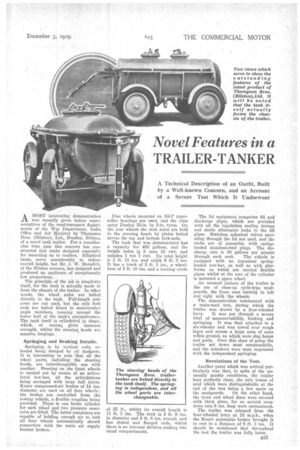Novel Features in a TRAILER-TANKER
Page 51

If you've noticed an error in this article please click here to report it so we can fix it.
AMOST interesting demonstration was recently given before representatives of the road-transport departments of the War Department, India Office and Air Ministry by Thompson Bros. (Bilston), Ltd., Bradley, Bilston, of a novel tank trailer. For a considerable time past this concern has constructed fuel tanks designed especially for mounting on to trailers. Elliptical tanks serve considerably to reduce overall height, but Mr. J. W. Meredith. of the Bilston concern, has designed and produced an appliance of exceptionally low proportions.
The principle of the job is simplicity itself, for the tank is actually made to form the chassis of the trailer. In other words, the wheel axles are bolted directly to the tank. Full-length axle arms are not used, but the axle fork ends are bolted direct to semicircular angle members, running around the lower half of the tank's circumference. The tank itself is cylindrical in shape, which, of course, gives immense strength, whilst the steering_ heads are massive forgings.
Springing and Braking Details.
Springing is by vertical coils, rebound being damped by oil dashpots. It is interesting to note that all the wheel parts, including the steering heads, are interchangeable one with another. Steering on the front wheels is carried out by means of an articulated tow-bar, all the articulations being arranged with large ball joints. Knorr compressed-air brakes of 14 ins. diameter are used on all four wheels ; the brakes are controlled from the towing vehicle, a flexible coupling being provided. There is one brake cylinder for each wheel and two pressure reservoirs are fitted. The latter containers are capable of holding enough air to lock all four wheels automatically should connection with the main air supply become broken. Disc wheels mounted on SKF taperroller bearings are used, and the rims carry Dunlop 33-in. by 5-in. tyres. On the i.ear wheels the stub axles are held in the steering heads by plates bolted across the top and bottom fork-ends.
The tank that was demonstrated has a capacity for 450 gallons, and the weight ladon is 2 tons 16 cwt. and unladen 1 ton 7 cwt. Its total height is 5 ft. 11. ins, and width 6 ft. 3 ins. It has a track of 5 ft. 3 ins., a wheelbase of 5 ft. 10 ins, and a turning circle
of 25 ft., whilst its overall length is 11 ft. 3 ins. The tank is 3 ft. 6 ins. in diameter and 8 ft. 6 ins, overall, and has dished and flanged ends, whilst there is an internal division making two equal compartments. The lid equipment comprises fill and discharge pipes, which are provided with all the regulation sealing devices and static eliminator locks to the fill pipes. Stainless spherical valves operating through the lid are used, and the cocks are of gunmetal, with springloaded stainless-steel plugs. The discharge rate is 80 gallons per minute through each cock. The vehicle is equipped with an ingenious springloaded tow-bar, as well as with platforms on which are carried flexible pipes, whilst at the rear of the cylinder is mounted a spare wheel.
An unusual feature of the trailer is the use of close-up cycle-type mudguards, the front ones turning to left and right with the wheels.
The demonstration commenced with a main-road test, during which the trailer was drawn by a four-wheeled lorry. It was put through a severe trial of manceuvrability, braking and springing. It was then attached to a six-wheeler and was towed over rough lanes and across a large area of open waste ground, on which were slag heaps and pools. Over this class of going the trailer sat down most commendably, and the onlookers were most impressed with the independent springing.
Revelations of the Test.
Another point which was noticed particularly was that, in spite of the unusually muddy conditions, the trailer kept perfectly clean, the only traces of mud which were distinguishable at the end of the test being a few spots on the mudguards. On the other hand, the tyres and wheel discs were covered with thick slime, for on several occasions ruts 8 ins, deep were encountered.
The trailer was released from the four-wheeled lorry at 15 m.p.h., when the Knorr automatic brakes brought it to rest in a distance of 6 ft 3 ins. It should be mentioned that throughout the test the trailer was fully laden.




















































































































